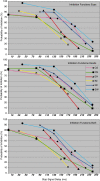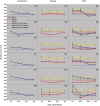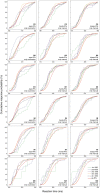Stopping eyes and hands: evidence for non-independence of stop and go processes and for a separation of central and peripheral inhibition
- PMID: 24600371
- PMCID: PMC3927451
- DOI: 10.3389/fnhum.2014.00061
Stopping eyes and hands: evidence for non-independence of stop and go processes and for a separation of central and peripheral inhibition
Abstract
In the stop-signal paradigm, participants perform a primary reaction task, for example a visual or auditory discrimination task, and have to react to a go stimulus as quickly as possible with a specified motor response. In a certain percentage of trials, after presentation of the stimulus (go signal), another stimulus (stop signal) is presented with a variable stop-signal delay. Whenever a stop signal occurs, the participant is asked to inhibit the execution of the response. Here, an extended test of the popular horse race model for this task (Logan and Cowan, 1984) is presented. Responses for eye and hand movements in both single-task and dual-task conditions were collected. Saccadic reaction times revealed some significant violations of the model's basic assumption of independent go and inhibition processes for all six participants. Saccades that escaped an early stop signal were systematically slower and had smaller amplitudes compared to saccades without a stop signal. Moreover, the analysis of concomitant electromyographic responses recorded from the upper arm suggests the existence of two separate inhibitory mechanisms: a slow, selective, central inhibitory mechanism and a faster, highly efficient, peripheral one, which is probably ineffective for saccades.
Keywords: eye-hand coordination; hand movements; inhibitory control; race model; saccadic reaction time; stop signal.
Figures






References
-
- Baddeley A. D. (1986). Working Memory. Oxford, New York: Clarendon Press; Oxford University Press
LinkOut - more resources
Full Text Sources
Other Literature Sources

